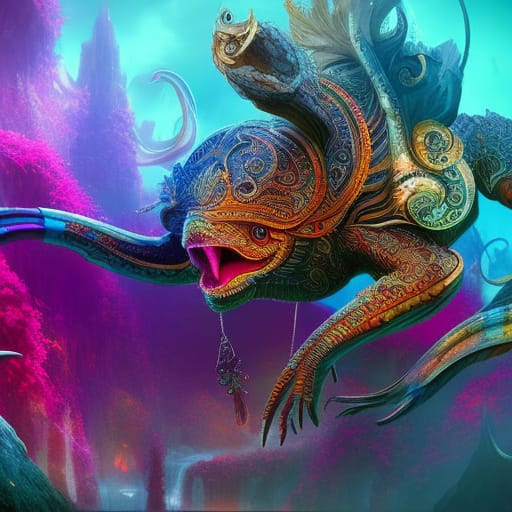Strisilae
The Strisilae is an aquatic lizard that is known to be highly territorial and vicious. Despite their diet of only fish and water grasses and plants, they have been known to kill unsuspecting swimmers and seamen who wander into their territories. They fatality rate is so high that sightings of them are treated as serious threats and dealt with as soon as possible.
Basic Information
Anatomy
They are large animals reaching lengths of up to 5 feet. They have long arms with sharp claws measuring up to 6 inches long in a fully mature adult. Their backs and necks are protected by hard shell like skin, that flares up into a hood on their head with a secondary longer layer below that covers their spines and flares up art their tails.
It can be hard to notice them in the water due to the large coral like protrusion from their spines that serve as camouflage for them as they lay on the sea floor. Their coloration also makes them hard to spot as they blend in almost seamlessly with colored stones of their favored reefs.
Genetics and Reproduction
Mating season for them tends to be in the early spring and comes with severe danger for fishermen, swimmers, and seafarers alike. This is because during this time large numbers of Strisilae will congregate in one area for the duration of the month long mating season. Gestation lasts about 4 weeks before eggs are laid, usually in clutches of 15 eggs.
Growth Rate & Stages
Hatchlings:
Upon hatching the young will immediately begin to feed and hunt within their parent's territory though they tend to stay close to the cave home the mother has chosen still requiring a portion of their diet from their mother's hunting and don't wander very far. This stage they are incredibly vulnerable as their armored hood and back have not yet hardened.Juvenile:
After a period of about 6 weeks the hatchlings will begin to venture further into their parent's territory and begin hunting in earnest. At this stage their armor is still relatively soft but is strong enough to defend them from most predators in the wild. This is the ideal stage for hunters to deal with an infestation but not one that is easy to catch.Adult:
At roughly a year old the young will finally venture outside of their mother's territory before she turns on them, and find a place for themselves. At this point they are considered fully mature though they won't finish growing for another two years. At this stage they are considered a serious threat and if found are either chased away or ideally exterminated quickly.Dietary Needs and Habits
Their diets consist of various fish and small aquatic creatures as well as crabs and shell fish. They also are capable of and occasionally eat various water based plants and flora such as seaweed and kelp.
Behaviour
They are highly territorial creatures with a vicious streak. They will only tolerate their young and if they feel threatened or find another predatory creature within their territory they will attack with intents to kill. They are known to keep chasing intruders beyond their claimed territory as well. The Strisilae is known to be one of the leading causes of death for seaside villages, towns, and cities as well as travelers along the coasts of Glenerene. As such they are listed as one of the most deadly creatures in the civilized world.
Additional Information
Perception and Sensory Capabilities
While they have no extraordinary extra senses their senses of smell and sight are incredibly good, able to spot minor movement at 60 feet.
Lifespan
15 Years
Conservation Status
They are considered dangerous pests and to be avoided and reported if spotted.
Average Length
5 Feet
Body Tint, Colouring and Marking
They are usually brightly colored in a myriad of blues, purples, pinks, and reds with yellow swirling patterns on their backs.





Comments